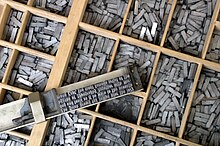Lead type

Lead type is a process for the production of printing forms for letterpress printing . Individual letters or letters cast from letter metal , a lead - tin - antimony alloy, are put together to form the complete shape of a page. After printing, the printing form can be dismantled again into its individual parts (" filed ") and the letters can be used again. The prerequisite for this is single type typesetting by hand or with the Monotype typesetting machine. Machine set with cast lines, as supplied by the Linotype or Ludlow casting machines , is melted down again after use and cast again.
history
The basis for this technique was created around 1440 by Johannes Gutenberg , who redeveloped printing with movable type or "mobile letter printing". However, printing with reusable and metal letters existed before Gutenberg. Finds from China (see also the relevant department and documentation in the Gutenberg Museum in Mainz ) and Korea allow the conclusion that there is a so-called re-invention of the system in Europe. What was definitely new was the use of soft metals such as lead and tin as well as the construction of a casting instrument with an exchangeable die. The typesetting techniques also differ in that the Asian sentence is based on character strings (pictorial words) and the European on separate letters.
Types of lead types
A distinction is made between manual typesetting - the oldest form, which largely disappeared only in the 1970s - and machine typesetting . The machine set is further divided into three different functional principles. Type setting machines use the typefaces from hand typesetting (e.g. the Kastenbein typesetting machine ). The exclusion of the line continues to run before manually or readjusted. In the Monotype single letter setting and casting machine , new letters are cast from dies. With line casting machines (e.g. Linotype typesetting machine , Typograph ), the text line consists of a single piece. For this reason, a faulty line on line casting machines must be set again and poured. Exclusion and formatting take place in the first sentence step and cannot be corrected later. The different techniques have often been used side by side. With approx. 6000 characters per hour, the casting machines were able to far surpass the typesetting performance of a handset (up to 1500 characters). Later these types of machine typesetting were also replaced by newer typesetting techniques , such as photo typesetting or computer typesetting.
Typesetting language and mathematics
Many of the typographical terms and rules from the lead type era are still valid today and have even been carried over to desktop publishing .
A specialty of manual typesetting was z. B. systemic computing. It is always possible to create a precise rectangle through a systematic combination of text and exclusion material. The typographical system is based on the typographical point and the dodecahedral calculation model ( point , Cicero = 12 pt, concordance = 4 Cicero). Starting from a thickness of ½ point up to the size of several concordances, all font sizes and spacers can be combined without any gaps.
See also
- Printer language
- Fly head
- Manuscript holder (tenacle and divisorium)
- Rate calculator
- Sentence board
- Block closers
- typesetter
- Type case
- Typesetting machine
- Standing sentence (standing sentence)
- Walking distance
- Angle hook
- Whore child and cobbler boy
- Onion fish (letterpress)
literature
- Eberhard Dilba: Typography-Lexicon and Reader for All, 2nd Edition, Books on Demand, Norderstedt 2008, ISBN 978-3-8334-2522-6 .
- Sepp Dußler, Fritz Kolling: Modern typesetting . 4th edition. Verlag Documentation Saur KG, Pullach 1974, ISBN 3-7940-8703-8 .
- Fritz Genzmer: The typesetter's book. 9th edition. Ullstein Fachverlag, Berlin 1967.
- Josef Buyer: The typesetting textbook. 5th edition. Blersch Stuttgart publishing house 1956.
- Hans-Jürgen Wolf: History of the graphic process. A contribution to the history of technology . Historia Verlag, Dornstadt 1990, ISBN 3-9800257-4-8 .
Web links
- Museum of Printing Art in Leipzig
- Hand typesetting in the 21st century
- Typography lexicon by Eberhard Dilba with 200 pages, over 900 main keywords and over 60 illustrations (PDF file)
- Gutenberg Museum Mainz / World Museum for Printing History
- Office for printing and book culture / historical book printing - gallery - printing shop
- Metal type & typesetting machines in pictures
- Offizin Parnassia Vättis Switzerland active type foundry - Monotype metal type - letterpress

